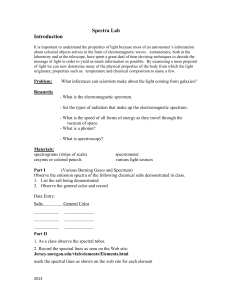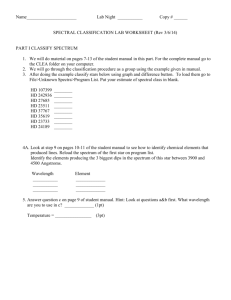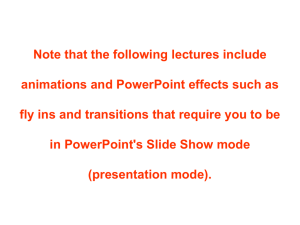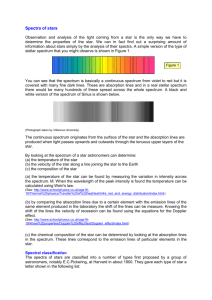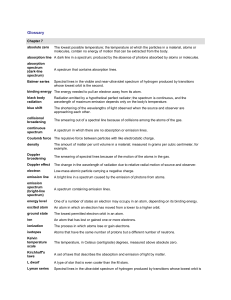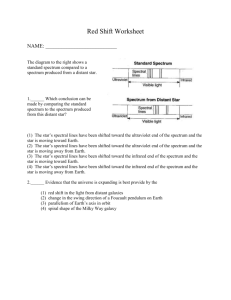Chapter 7: Study Guide
advertisement
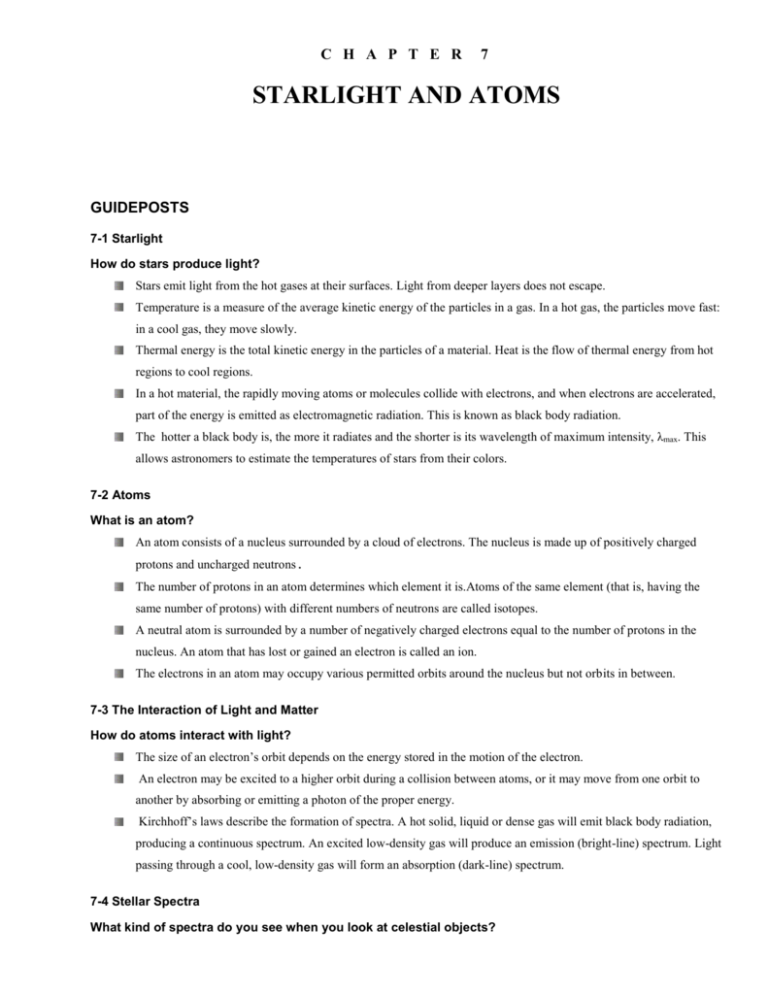
C H A P T E R 7 STARLIGHT AND ATOMS GUIDEPOSTS 7-1 Starlight How do stars produce light? Stars emit light from the hot gases at their surfaces. Light from deeper layers does not escape. Temperature is a measure of the average kinetic energy of the particles in a gas. In a hot gas, the particles move fast: in a cool gas, they move slowly. Thermal energy is the total kinetic energy in the particles of a material. Heat is the flow of thermal energy from hot regions to cool regions. In a hot material, the rapidly moving atoms or molecules collide with electrons, and when electrons are accelerated, part of the energy is emitted as electromagnetic radiation. This is known as black body radiation. The hotter a black body is, the more it radiates and the shorter is its wavelength of maximum intensity, λmax. This allows astronomers to estimate the temperatures of stars from their colors. 7-2 Atoms What is an atom? An atom consists of a nucleus surrounded by a cloud of electrons. The nucleus is made up of positively charged protons and uncharged neutrons. The number of protons in an atom determines which element it is.Atoms of the same element (that is, having the same number of protons) with different numbers of neutrons are called isotopes. A neutral atom is surrounded by a number of negatively charged electrons equal to the number of protons in the nucleus. An atom that has lost or gained an electron is called an ion. The electrons in an atom may occupy various permitted orbits around the nucleus but not orbits in between. 7-3 The Interaction of Light and Matter How do atoms interact with light? The size of an electron’s orbit depends on the energy stored in the motion of the electron. An electron may be excited to a higher orbit during a collision between atoms, or it may move from one orbit to another by absorbing or emitting a photon of the proper energy. Kirchhoff’s laws describe the formation of spectra. A hot solid, liquid or dense gas will emit black body radiation, producing a continuous spectrum. An excited low-density gas will produce an emission (bright-line) spectrum. Light passing through a cool, low-density gas will form an absorption (dark-line) spectrum. 7-4 Stellar Spectra What kind of spectra do you see when you look at celestial objects? Because orbits of only certain energies are permitted in an atom, photons of only certain wavelengths can be absorbed or emitted. Each kind of atom has its own characteristic set of spectral lines. The hydrogen atom has the Lyman series of lines in the ultraviolet, the Balmer series in the visible, and the Paschen series (and others) in the infrared. If light passes through a low-density gas on its way to your telescope, the gas can absorb photons of certain wavelengths, and you see dark lines in the spectrum at those positions. Such a spectrum is called an absorption spectrum. If you look at a low-density gas that is excited to emit photons, you see bright lines in the spectrum. What can you learn from a star’s spectrum? Nearly all stellar spectra are absorption spectra, and the hydrogen lines seen there are Balmer lines. In cool stars, the Balmer lines are weak because atoms are not excited out of the ground state. In hot stars, the Balmer lines are weak because atoms are excited to higher orbits or are ionized. Only at medium temperatures are the Balmer lines strong. The strength of spectral lines in a star’s spectrum can tell you its temperature. In its simplest form, this amounts to classifying the star’s spectrum in the spectral sequence: O, B, A, F, G, K, M. Long after the spectral sequence was created, astronomers found the L and T stars at temperatures even cooler than the M stars. A spectrum can reveal the chemical composition of the stars. The presence of spectral lines of a certain element shows that that element must be present in the star. But astronomers must proceed with care. Lines of a certain element may be weak or absent if the star is too hot or too cool. The wavelengths of spectral lines provide clues to the motions of the stars. When a star is approaching, you observe slightly shorter wavelengths (a blueshift); when it is receding, you observe slightly longer wavelengths (a redshift). This Doppler effect reveals a star’s radial velocity, that part of its velocity directed toward or away from Earth. The shape of a spectral line can reveal the rotation of a star because one side of the star approaches Earth while the other side recedes. The Doppler shift broadens the star’s spectral lines. Doppler broadening can make spectral lines wider because the atoms in a hot gas move very rapidly and at any moment some are receding and some are approaching. Collisional broadening occurs in a dense gas where the atoms collide often. This widens spectral lines. CHAPTER OUTLINE Guideposts 7-1 Starlight Temperature and Heat The Origin of Starlight Focus on Fundamentals (3) Heat and Thermal Energy Two Radiation Laws The Color Index Building Scientific Arguments: Wavelength and Temperature. Stefan Boltzmann Law. 7-2 Atoms A Model Atom Different Kinds of Atoms Window on Science 7-1 Quantum Mechanics: The World of the Very Small Electron Shells Building Scientific Arguments: Hydrogen Atoms across a Pinhead. Hydrogen Atoms equal to a Paper Clip. 7-3 The Interaction of Light and Matter 7-4 The Excitation of Atoms The Formation of a Spectrum Building Scientific Arguments: Spectrum of Molten Iron. Spectrum of Hot Gases. Concept Page: Atomic Spectra Stellar Spectra The Balmer Thermometer Spectral Classification The Composition of Stars The Doppler Effect How the Doppler Shift Works Calculating the Doppler Velocity The Shapes of Spectral Lines Focus on Fundamentals (4) Density Building Scientific Arguments: Lines in the Spectrum of the Sun. Lines and Star’s Radial Velocity.

